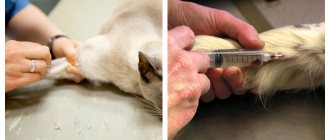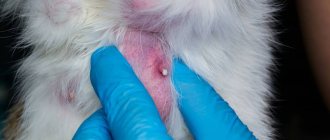Pets, despite all the measures taken, can still become infected with serious infections, one of which is staphylococcus in cats. For this to happen, it is not at all necessary for a cat to live on the street or eat in garbage dumps.
To become infected with a staphylococcal infection, contact with a sick animal during a short walk or sniffing the owner’s outdoor shoes will be enough.
Who is staphylococcus?
Cases of staphylococcus disease in domestic cats have recently become more frequent, and this infection is severe in them even with correct and timely treatment. But, despite this, a competent approach from the attending physician and effective treatment methods can overcome the disease and significantly improve the animal’s well-being.
Staphylococcus belongs to pathogenic microorganisms whose structure resembles a bunch of grapes. There is no one specific pathogen that causes staph infection. This definition includes a whole genus of microorganisms that have common characteristics and cause a characteristic type of disease. This microbe was first discovered back in 1881, and to this day, undergoing various changes, it remains able to withstand the effects of the most modern drugs. In the animal's body, staphylococcus affects various organs, in which, under the influence of a pathological process, purulent inflammation occurs. If the disease cannot be stopped, the functioning of important systems deteriorates, often resulting in fatal complications.
The insidious nature of staphylococci lies in the fact that after entering the animal’s body, they may not show their activity and remain in this state for a long time. However, after some shock they can begin to develop sharply and lead to serious violations.
Staphylococci are considered opportunistic microorganisms, since they cause harm to the body only under the influence of a certain factor. According to scientists studying this area of medicine, today many infections, which include those whose etiology is unclear, are caused by these microorganisms.
Predisposing factors
Staphylococcus in cats manifests its activity under the influence of certain factors; they infect the animal, which itself becomes a source of infection and can infect others. The most important reasons that can influence the development of the infectious process in the body of cats are as follows:
- A change in the processes of carbohydrate metabolism that occurs as a result of the development of diabetes or the cat’s poor diet, which contains insufficient amounts of minerals and vitamins.
- Weakened immunity, which decreases after illness, and is also at this level from birth. Most often, cats in this condition are affected by Staphylococcus aureus, which causes severe purulent inflammation that is difficult to treat.
- Hormonal imbalances, which are more common in older cats.
- Cases of intoxication, as a result of which the animal’s body’s defenses are weakened. Usually, after poisoning, the animal’s condition and well-being decreases, which gives rise to the development of a staphylococcal infection.
- A state of acute vitamin deficiency, microorganisms especially react to a lack of B vitamins, as well as carotene and vitamin E.
- The presence of skin pathologies in the form of dermatitis, eczema, lichen, as well as allergies often become the reason for the development of staphylococcal lesions.
The risk of becoming infected with staphylococcus increases many times if the cat is accustomed to outdoor walking. Participation in fights also increases the possibility of infection, as the inevitable breaks in the skin then become inflamed, thereby encouraging the development of infection.
Description of the microorganism
Staphylococcus is a group of bacteria. Currently, several varieties of these microorganisms are distinguished:
- saprophytic;
- epidermal;
- golden.
The most common type of bacteria is golden. It causes severe inflammation with suppuration.
Translated from ancient Greek, the word “staphylos” means “bunch of grapes”. This is where the name of the microorganism comes from. Staphylococci under a microscope look like spherical clusters of golden color.
Such bacteria are opportunistic microbes. Staphylococcus can stay in a cat’s body for a long time and not cause any damage. At this moment, the bacterium is in an inactive state. But under the influence of unfavorable external and internal factors, staphylococcus becomes pathogenic. This leads to painful manifestations. Most often, the emergence of pathogenicity is facilitated by a decrease in immunity.
Which breeds are most susceptible to infection?
Cats of any breed and even outbred cats, which are usually more resistant to any infections, are at risk of becoming infected with staphylococcus and subsequently falling ill. But still, the disease is more often diagnosed in hairless breeds, whose skin is less protected and more easily damaged. Bacteria penetrate through the scratches, and the lack of hair on the skin leads to hypothermia in animals. All this helps to reduce the animal’s resistance to the development of infection.
Long-haired cats, such as Persians, are no less likely to be infected. The nature of this breed is aggressive, and they are more likely than others to get into fights and receive wounds and scratches. The peculiarity of these animals, which have luxurious fur, is that staphylococcal infection is more severe in them.
Therapeutic measures
We have already said that there are a great variety of staphylococci. It is not surprising that their sensitivity to drugs varies. Therefore, the doctor will first of all seed the pathological material, grow a culture, and only then check which specific antibiotic to “kill” this infection. In addition to antimicrobial drugs, intravenous solutions are used to relieve intoxication. Good results are obtained by using a special phage (virus) that destroys staphylococcus colonies.
The animal is prescribed vitamin preparations to improve general well-being, and hormonal and healing ointments are used to treat wounds and erosions formed on the skin. If the staphylococcal infection was complicated by demodicosis, get rid of intradermal parasites. Fans of self-treatment of their pets should be immediately warned: only a veterinarian should think about how to treat your cat! You certainly won’t be able to cure staphylococcosis on your own, but you will certainly worsen the animal’s condition.
Can a cat infect a person?
Can a person become infected from a sick cat and what is the likelihood of this possibility - such questions are often asked at an appointment with a veterinarian.
Infection of a person by a cat with staphylococcus is quite acceptable, and this can happen in the following cases:
- contact method;
- nutritional;
- using the airborne method.
Most often, infection occurs during a bite, since even a small damage on the human skin left by the teeth of a sick animal will be enough for this. Infection is also possible if hygiene rules are not followed, since pathogenic microbes remain on the hands after playing with the cat or after cleaning its litter box.
It has been noted that most cases of infection from sick animals occur in the elderly and children. It is for this reason that in order to protect yourself and your loved ones from the possibility of infection with staphylococcus, it is necessary not only to wash your hands thoroughly, but also to be able to identify the disease at the initial stage by its first signs.
Can a person become infected with staphylococcus through his pet?
Many cat breeders are interested in this question, the answer is clear - you can get infected. This will happen if a person pets an animal and then touches his face, eyes, nose with unwashed hands, takes food, or picks his nose. It is also very common for owners to cuddle or kiss their pets. This is, of course, incredibly cute and the animal probably likes this manifestation of sympathy from a person, but you need to understand that such love can be harmful to health. After each contact with a cat, its owner should thoroughly wash their hands with soap and treat them with an antiseptic. Particular attention should be paid to cleaning the tray. This should absolutely not be done with bare hands, so as not to suddenly become infected with staphylococcus; be sure to wear rubber gloves. It is also worth knowing that if you are bitten by a sick animal, you must urgently visit a medical facility. There they should carefully examine your skin and order a bacteriological test for staphylococcus infection.
Diagnostics
If you suspect an infection or the development of an infection in cats, you must meet with a veterinarian and carry out the prescribed tests.
Since staphylococcal infection has a number of similar symptoms to other diseases, diagnosis includes the following:
- analysis of blood samples for bacterial culture;
- microscopic examination of scrapings from areas of skin with lesions;
- study of smears of discharge from the genital tract.
As a rule, a general blood test is not carried out in this case due to its lack of information, for the reason that changes in the blood from exposure to staphylococcus can only be detected in the stage of sepsis.
Causes
Most often, the bacterium enters the human body through wounds and microcracks in the skin. The infection, having penetrated through the wound, begins to multiply in the blood, spreading throughout the body and affecting the lungs, heart, brain, liver, kidneys, and joints.
With staphylococcus, diseases can be very different, such as pneumonia, meningitis, osteomyelitis, endocarditis, sepsis and many others.
Staphylococcus infection can occur in the following ways:
● Through contact and household use when using the patient’s personal items;
● Airborne droplets during close contact with an infected person;
● Fecal-oral on dirty fruits, vegetables and other food products, dirty dishes and hands;
● Vertical when a child passes through the birth canal of an infected mother during childbirth.
● Infection often occurs during surgery through medical instruments and during various manipulations.
Clinical manifestations
Manifestations of the disease can be seen with the naked eye, therefore, with careful attention to your pet, staphylococcal infection is detected already at its initial stage. The main symptoms are:
- Dermatitis that lasts a long time and is difficult to treat. Often, as a result of severe dermatitis, a complication develops in the form of pyoderma with a purulent inflammation of the skin. The pathology begins with small erosive areas with severe itching, which, in the absence of timely treatment, turns into weeping dermatitis.
- The appearance of individual areas of baldness. Typically, such areas of the skin are accompanied by an unpleasant odor with the release of exudant fluid. This is more often observed in older cats and those who are obese. In the absence of timely treatment, the damage spreads to the tissue located in the subcutaneous layer. Its tissues are rapidly destroyed with the formation of inflamed boils in their place.
With the activity of staphylococcus and with the further development of the infection, along with damage to the skin, other, no less pronounced symptoms may be observed. Most often, a sick animal experiences severe weakness, fever, loss of appetite and severe thirst.
Other manifestations
The causative agent of staphylococcal infection in cats can cause damage not only to the skin, but also have a detrimental effect on other organs. Symptoms of staphylococcus in a cat are as follows:
- First of all, the disease affects the organs of the reproductive system. In females, inflammation, which initially occurs in the vagina, soon spreads to the uterine cavity with the development of endometritis. In cats, inflammation of the foreskin occurs with purulent discharge.
- Damage to the hearing organs occurs with the development of chronic otitis, in which the animal experiences pain, shakes its head and does not allow its ears to be touched.
- The development of purulent conjunctivitis, when not only the eyes swell and fester, but vision can also sharply decrease.
- Often, a complication of staphylococcal infection is kidney damage, accompanied by pain when urinating with cloudy urine.
- If the infection affects the liver, the animal may experience yellowing of the mucous membranes.
Note! Any of these symptoms should alert the cat owner, since even if such manifestations are not a symptom of staphylococcus infection, then they are definitely an indicator of trouble in her body.
Lesions of the genital area
The most reliable sign of staphylococcal infection is obvious changes in the condition of the mucous membranes covering the genitals. Cats with this diagnosis most often suffer from purulent vaginitis, which easily takes a more serious form in the form of endometritis. In this case, exudate is noticed from her genital tract.
Cats often experience inflammation of the foreskin, also characterized by purulent discharge. If the inflammatory process spreads to the preputial sac of the genital organ, then the animal experiences severe swelling, difficulty and pain when urinating, i.e. postitis. When conducting a microscopic examination of purulent fluid, a large number of staphylococci with various strains are found in it.
Complications
The future fate of the pet is largely influenced by the timeliness of the treatment, especially in the case of Staphylococcus aureus in a cat. Incorrectly administered therapy or its absence in advanced cases very often leads to the development of sepsis, with signs of blood poisoning. During the examination, you can detect a large number of bacteria constantly circulating in the blood plasma. As a result of the activity of these microorganisms, toxins accumulate in the blood and do not have time to be eliminated from the body. Such changes affect the functioning of the cardiovascular system, disturbances in which often result in septic shock and death of animals.
It is possible to defeat parasites!
Antiparasitic Complex® - Reliable and safe removal of parasites in 21 days!
- The composition includes only natural ingredients;
- Does not cause side effects;
- Absolutely safe;
- Protects the liver, heart, lungs, stomach, skin from parasites;
- Removes waste products of parasites from the body.
- Effectively destroys most types of helminths in 21 days.
There is now a preferential program for free packaging. Read expert opinion.
Read further:
Long worms in cats: main types, description and methods of treating parasites in cats
Staphylococcus aureus in the nose of a child: symptoms and treatment
Staphylococcus aureus in the ear of an adult and a child, treatment methods
What diseases does Staphylococcus aureus cause in humans?
Staphylococcus aureus in the stool, nose, throat and intestines: symptoms, degrees of infection and treatment
Doctor Komarovsky about Staphylococcus aureus in children (infants)
Treatment
Treatment of staphylococcal infections requires complex therapy that lasts a long time. First of all, a sick cat is prescribed a drug that actively affects the very cause of the disease. Thus, with the help of ASP, which is a polyvalent antistaphylococcal toxoid, bacteria are actively destroyed. Antibiotics and antibacterial external preparations complement complex therapy.
Most often prescribed for this purpose:
- Azithromycin;
- Amikacin;
- Baytril;
- Cyflox.
With the help of Streptocide or Sulfacyl ointment, as well as Manefid, wound healing and antiviral effects are exerted on damaged areas of the skin, resulting in faster recovery. The use of Antistaphylococcal bacteriophage destroys any strains of staphylococci. In case of severe dehydration and intoxication of the animal's body, droppers with saline solution are indicated.
Treatment at home
You cannot treat a sick animal with a staphylococcal infection yourself at home, as this can lead to its death in the shortest possible time. The development of a pathological process in the absence of professional medical care from a veterinarian very quickly leads to septic shock, which is fraught with irreversible processes that threaten death.
Any warning signs consistent with a staph infection should promptly contact your veterinarian. It is allowed to treat an animal at home, but only with the help of the prescriptions made by a specialist.
How to treat staph in your pet
Immediate contact to a veterinary clinic is required. Treatment of a cat infected with Staphylococcus aureus should be carried out strictly under the supervision of a veterinarian in a clinical setting. Under no circumstances should you attempt to treat the animal yourself, as this can lead to the death of the cat.
The main medication is usually prescribed one of the antibiotic options that has an effect on gram-positive coccal infections. In severe cases, an IV may be prescribed.
Additionally, vitamin preparations are prescribed as strengthening agents. The affected skin is treated with special medicinal ointments. General intoxication of the body is eliminated by absorbent agents.
Over time, if measures are not taken in time, the disease may become incurable.
Consequences of staphylococcus for cats
A serious consequence of staphylococcus infection for cats can be considered weeping dermatitis, which is difficult to treat with medications and brings a lot of suffering to the animal. Further progression of this disease contributes to a more widespread spread of pathology on the animal’s body, not excluding its head and muzzle. Kittens from dehydration caused by this disease in most cases do not survive and die in the first week of illness.
As a result of the development of Staphylococcus aureus, animals undergo changes in a variety of organs. Staphylococcus in a cat's ears leads to chronic forms of otitis and purulent conjunctivitis.
You can find symptoms that indicate Staphylococcus aureus in your cat's nose, with an erosive surface forming around the nose and mouth.
Adult cats are also often unable to get a staphylococcal infection as a result of infection of the body with pathogenic microbes. Their large accumulation leads to poisoning of the body with toxins released by microorganisms as a result of their existence. The development of septic shock is the main cause of death in animals of any age.
Risk groups: pregnant women
Human immunity is able to control infection, but not in all cases. For example, the female body is exposed to harmful bacteria, but its natural defense blocks the action of a saprophytic bacterium, which is dangerous because it is accompanied by inflammation of the kidneys and bladder. Staphylococcus is often detected in pregnant women, since during this period the expectant mother’s immunity weakens.
Doctors suggest taking a test to determine the presence of infection. It is not always active, so treatment is not required in every case. In some situations, preventive measures are sufficient to avoid unpleasant consequences. Contact with Staphylococcus aureus during pregnancy is dangerous for the woman and baby, because the bacterium can infect the membranes and fetus. If such a variety is detected, the doctor tells you how to get rid of staphylococcus in the body.
Prevention
It is much easier to prevent cats from becoming infected with staphylococcus by taking effective preventive measures than to then treat them for a long time and persistently for this serious disease, often accompanied by complications. To do this, it is important to prevent your pet from coming into contact with street stray dogs and cats. It is important to fill his diet with necessary microelements and vitamins, but it is better to protect the cat from excess carbohydrates in the diet. It is important to prevent the development of chronic diseases in cats, and in case of any diseases, take care of their elimination. Particular attention should be paid to antiparasitic treatment - the presence of fleas can cause increased activity of staphylococcus and lead to more severe skin lesions.











